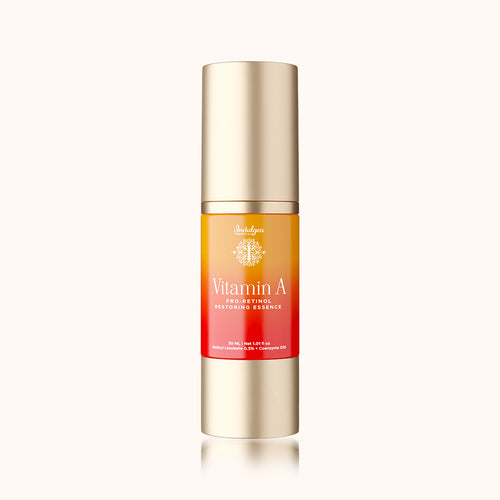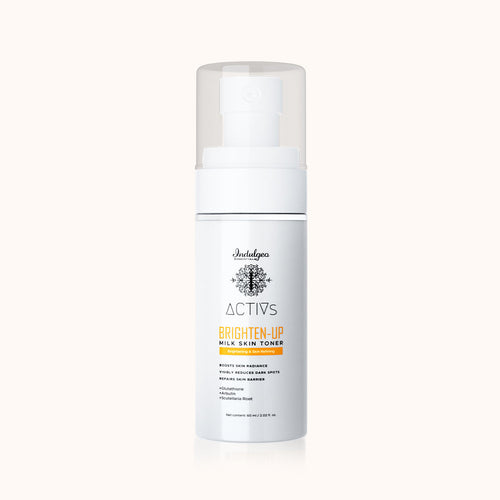
Retinyl linoleate — the infusion your skin desires
Share
Hey ladies — We know how the onset of fine lines and wrinkles, hyperpigmentation, acne, and dull skin tone can get y’all worked up — enforcing you to hoard your beauty arsenal with all the hardest-working products for treatment.
But don’t you worry. We’ve got a one-stop solution for all your skin woes that promises to save your trips to the dermatologist’s office this year.
While undoubtedly, the miraculous skin care ingredient — Retinol — might have become a household name to you by now but we’re sure you’re not aware of the many forms of it out there and the myriad roles it can play to be your ‘beloved ingredient’ to rock the flawless out-of-the-spa glazed look you always desired.
How is Retinyl Linoleate different from Retinol?
Retinol is a type of retinoid, (a derivative of vitamin A), famed for its anti-ageing properties. This powerhouse ingredient vaguely needs to go through a 2-tier process to actually work, which involves its conversion to retinaldehyde, and then to the active form retinoic acid. It is widely known as the ‘gold standard for stimulating the metabolism of skin cells and encouraging collagen production to resurface the skin’s texture for a smoother, more even-toned look.
While a boon for many, it can be a bane for super sensitive skin due to its side effects of dryness, peeling, and irritation. It can sometimes also be damaging to your skin if you have super-sensitive underlying skin conditions like eczema or rosacea.
Hence, enter — Retinyl Esters — One of the best ones being ‘Retinyl Linoleate’.
Retinyl esters are the mildest types of retinoids that, unlike retinol, go through a 3-tier conversion process under your skin to become active. The more steps there are in that process, the milder the ingredient is, and the results you see take some more time than retinol. On the other hand, you’ll also experience fewer unwanted side effects, like redness, peeling, and dry skin, making them the star choices for sensitive, reactive skin and anyone new to retinoids, (as they are unlikely to cause any irritation).
Let’s take a closer look at how this sprung up ‘It skin-care ingredient’ is considered a holy-grail solution for many of the most common skin issues — ones that have only been exacerbated by an influx of ageing and pandemic stress.
Why Retinyl Linoleate is the Secret Weapon for Healthier Younger Looking skin?
Skincare should be hard, neither on the skin nor on you. Over the many years of trials and trends, we’ve settled on one golden rule: Stick to the good stuff. Retinyl Linoleate is just that. Below are a plethora of benefits that make Retinyl Linoleate a gem to include in your skincare regime.
1. All for looking and feeling young
Retinyl Linoleate is that magic bullet that comes close to sculpting perfection on your skin while repressing the downsides of skin irritation & excessive dehydration. Just as good as pure retinol, it helps increase collagen synthesis, which helps improve skin elasticity and decrease fine lines. Using this ingredient is the key to ageing gracefully while it renders its magical powers for a tightened appearance and plumped oh-so-graceful skin.
2. Iconic ingredient to battle acne
Plagued by acne problems your whole life? Here’s a sigh of relief for you. A boon for acne-prone skin, this ingredient is a no-brainer for its duties to shrink and unclog pores or excess oil, practically tackling the root cause of acne. Trust us: We’re not alone in my love of retinyl esters—ask any dermatologist, facialist, or skincare guru about its deep therapy for acne, and they’ll all tell you the same thing: this stuff really WORKS.
3. Works wonders for hyperpigmentation, uneven skin tone & dark spots
Seeking a quick way to get rid of hyperpigmentation, uneven skin and dark spots? Look no further. A gold standard for fortifying the production of hyaluronic acid & suppressing melanin production, this ingredient effectively helps with weakening pigmentation, correcting dark spots and re-establishing even skin tone. With the promise of leaving absolutely zero challenging marks and affected areas behind, it is likely your best bet for a clearer even-toned skin tone.
4. Rocks that healthy skin tone
Prized for its proven host of skin benefits, this ingredient stimulates cell turnover and collagen synthesis, which also aids the skin in becoming more vibrant and smoother over time. Reviving your skin to be at its optimal health, it ensures transforming your dull skin into obsession-worthy bright skin within no time. Hey you, be ready to say hello to an even more gorgeous version of you.
5. Farewell, free radicals
We bet you already know that wearing sunscreen and introducing antioxidants into your diet and skincare routine can be your top defence against free radicals. Now, here’s something you must know — Vitamin A is essentially an antioxidant known to help reduce visible damage caused by free radicals, and the same is true of vitamin A derivatives and esters, including Retinyl Linoleate. Summer hats this season? No more!
What ingredients should you couple with Retinyl Linoleate?
Your skin deserves a routine as unique as you are. Coupling ingredients with the right partners can amplify their effectiveness and can be one of the best ways to make the most bang for your buck. So to help get you started, we curated a list of ingredients that can be coupled with Retinyl Linoleate —and the ones you should ditch.
Retinyl Linoleate + Hyaluronic Acid: Some mild reactions while using Retinyl Linoleate can be dryness or peeling. Hence, it is best to use it with a hydrating ingredient that counteracts its drying effect. An alpha humectant in the ingredient list, together they’re the slaying power couple.
Retinyl Linoleate + Niacinamide: Working as a power duo to heal all the skin woes including acne, wrinkles, and fine lines; work together side by side to counteract each other’s weaknesses. They can be even mixed together for application and require no waiting for layering!
What ingredients should you ditch with Retinyl Linoleate?
Retinyl Linoleate + Glycolic/salicylic acid (BHAs): Prized for their ability to increase cell turnover and slough away dead skin cells to keep pores clear; Salicylic/Glycolic acid and our star ingredient together don’t make the best cheerleaders for your skin. Using these ingredients in conjunction should be avoided as it can be overdrying and too harsh on your skin.
Retinyl Linoleate + AHAs: Just another recipe for irritation on the skin is retinol mixed with alpha-hydroxy acids, like glycolic, lactic, and citric. Together these ingredients can disrupt the skin’s barrier and can cause excessive dryness and sensitivity. The only way to use both these products is by alternating the days for their application.
Retinyl Linoleate + Vitamin C: Providing a boosting effect to decrease pigment production & stimulate fibroblasts to improve collagen production; Vitamin C’s role is as vital as the ester’s. However, in tandem, they will not double your glow. Therefore, to keep them both as mainstays in the regimen, it’s best to use them during different times of the day as both used together can cause excessive dryness or irritation. Ideally, for optimal results, Vitamin C can be used in the morning while the ester can be used at night.
Retinyl Linoleate + Benzoyl Peroxide: Although both the potent ingredients are effective acne-fighting ingredients, Benzoyl peroxide and this iconic ingredient’s marriage should be avoided. When applied together, these two neutralise each other instead of enhancing the effects; making each one less effective and potentially increasing the risk of discomfort.
How to use Retinyl Linoleate in your skincare routine?
It’s just as crucial to know when and how often to use the ingredient on its own and in combination with other ingredients. For first time users, it is ideal to use it sparingly only at night, starting with the lowest concentration.
For optimal results, one can begin using it once or twice a week, and gradually increase the frequency as the skin gets used to it. Results also come with consistency, so once your skin has built up a tolerance for the ingredient, it’s essential to stick to your routine and use it nightly. On a side note, it is also advisable to use a broad-spectrum sunscreen during the day and limit sun exposure while using this product.
How long before you see results with Retinyl Linoleate?
With this ingredient, you’re in it for the longer run. Remember this: All good things take time. A milder yet effective version of pure Retinol with fewer dodgy side effects, this ingredient takes a little more time than Retinol to make the magic happen. Just as you wouldn’t run a marathon without proper training, give your skin time to get used to the intensity of this ingredient. It can generally take a few months to make out noticeable changes. Believing in the process and religiously following it is the key to eliminating your skin woes with Retinyl Linoleate.
Time to Age Gracefully With The Best Form Of Retinol
A total game-changer, our Vitamin A Pro-Retinol Restoring Essence translates the tried-and-true benefits of Retinol, lauded for its anti-ageing, acne battling and illuminating power, from the bottle to your skin.Perfect for an iconic overnight miracle, this cream provides a cellular therapy with a soothing, spa-worthy blend of the best ingredients. It is a unique formula for deep therapy for all your skin woes such as acne, dull complexion, hyperpigmentation, pores, fine lines & blemishes. So ladies, be prepared to experience the ‘wow factor’ of this highly concentrated-yet-gentle formula to help restore your skin’s radiance and improve elasticity, texture, and tone.
















